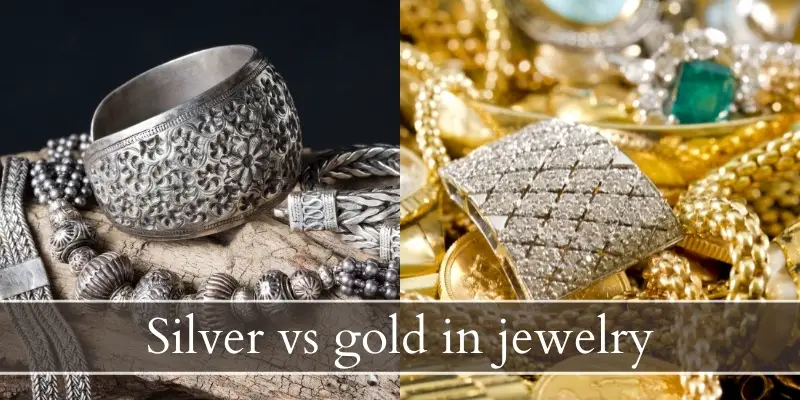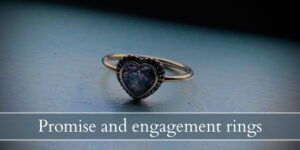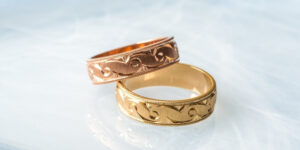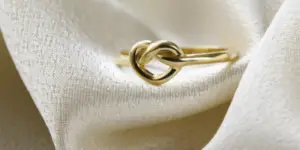Silver and gold are two of the main precious metals you can get your jewelry in. One is a warm yellow while the other is a light, grey-white and both have a metallic finish. While you can find other metals in a white color – palladium, platinum, titanium, rhodium coatings – gold is the only one that comes in yellow.
So the classic silver vs gold debate was born, ages ago, before jewelers knew to mix different metals and get different color gold. If you’re very new to the idea of jewelry and precious metals, here’s a comparison between gold and silver in jewelry. It’ll paint a rough picture of each metal, its weak and strong points, and this way you can make an informed decision (beyond appearance).

Silver vs gold jewelry
Silver jewelry tends to be softer than gold jewelry and it tarnishes quite fast, while gold jewelry does not really need polishing it too much upkeep. Gold jewelry is always more expensive than silver jewelry, and it wears better in time. That being said, each skin tone (cool, neutral, warm) is better complimented by either silver or gold so you should take that into account when deciding the jewelry metal.
In the long run gold is a better, if more expensive option for jewelry. It stands the test of time, it’s sturdier, and is can easily be coated in rhodium to achieve a white finish instead of yellow.
1. Silver requires more upkeep than gold
Silver easily oxidizes, compared to gold. Pure silver tarnishes and turns a dark color if exposed to air and not used for several weeks. Polishing silverware was a real thing back in the day, and if you’ve got a grandma with a nice silverware collection you’d definitely seen the state the metal can get in.
There is nothing wrong with silver for it tarnishing. It doesn’t mean you can’t wear or use it anymore, but it does mean it needs cleaning. A simple scrub with a very soft brush and warm soapy water can remove most of the tarnish, if it’s not severe.
Gold on the other hand requires barely any effort on your part. The higher the gold karat, the more pure gold there is in the jewelry. This means it may take years to tarnish, or not tarnish at all, depending on the karats. Pure 24k gold does not tarnish, ever, but it is very soft and cannot be worn daily.
Most gold jewelry you can buy is mixed with other metals but is still predominantly gold. So it will still not tarnish.
Read also: Why Does Gold Turn Black ?
2. Gold jewelry is more expensive than silver
Because gold is so coveted and downright useful, it’s always going to be more expensive than silver. This means that two rings, made exactly the same way, one in silver and one in gold, will have vastly different prices. Generally 14k gold is at least double the price of sterling silver. The higher the gold karat, the higher the price compared to silver.
Of course, you can find cheap ‘gold’ jewelry that can match sterling silver in price. Gold plated jewelry is much more affordable but if the gold plating is too thin, it will wear off in a couple of years.
If you’re the kind of person that likes to wear different jewelry pieces each day, and don’t want to blow your budget, silver is definitely a better option.
3. Silver works better for cool skin tones, gold for warmer ones
Skin tones are a a real thing, and they can make or break the color of your outfit, even your jewelry. In short, each person falls somewhere on the cool to warm spectrum. Remember, skin tone not skin color, this has nothing to do with melanin.
Some are more on the cool side, with a pinkish-blue tinge to their skin, a purple-blue veins. They look better in crisp, cool colors like deep blue, icy blue, pure white, silver, bluish purple, and so on.
Other people look much better in warm colors, like caramel, beige, fiery red, orange, and yes gold. These people tend to have a yellow tinge to their skin and their veins look rather olive green, than purple or blue.
And yet, some can’t make up their mind between gold or silver, since they’re a neutral tone. They look great in warm and cool colors, and can’t really tell if their veins have a blue or green tint.
Silver will always flatter a cool skinned person, so if you find that you’re such a person (I am !) you will naturally gravitate towards silver, or white gold, or platinum, or any white metal. Conversely, if you’re warm skinned you’ll look better in gold jewelry. And if you’re neutral, you can wear any of these metals !
Of course, this is an oversimplification. There are shades of gold that tread the line between gold and silver, like pale gold, or 18k white gold before a rhodium coating. These were just the general guidelines to follow.
Another guideline is to not wear gold and silver together. If you’re that lucky neutral skinned person, pick a single metal color when putting together your outfit. You will look more put together.
4. Most gold jewelry is harder than silver
When comparing gold and silver, one thing you have to take into account is the metal hardness. Pure silver and pure gold are both very soft metals, and they both need an alloy. But, in general the gold alloys on the market are a bit sturdier than the ring alloys.
This does not mean they won’t bend as easily, but rather they’re much more resistant to scratches than silver alloys. Even higher karat gold like 18k or 22k will fare better than sterling silver. Of course, both silver and gold jewelry will last you a lifetime. It’s just that the silver may slowly corrode in time and present small indentations.
5. Silver tends to go better with colored gemstones
This may be a very personal preference, but we’ve found that silver is a better match for colored gemstones. Being silvery-white, it provides a neutral color for the gemstone to contrast with. This means cool stones will appear cool, warm stones will appear warm, and the color itself will not be influenced by the metal.
For example a ruby set in silver will bring out its true color, while one set in yellow gold will tend to look warmer, even if the gemstone itself is not that warm.
Gold jewelry tends to look amazing with white gemstones, the most famous being diamonds. It’s no wonder the standard engagement ring is 18k yellow gold with a white diamond. It’s the color combination that makes white stones stand out the most !
Of course, you can get a diamond ring in white gold as well, but the stone may be lost in the overall metal, since there won’t be much of a contrast.
Both silver and gold are hypoallergenic metals
Silver and gold, at least in their pure forms, are hypoallergenic. This means they won’t trigger any allergic reactions. Even if the bulk of your jewelry is made of a different metal, having the part that touches your skin be silver or gold will help a lot.
One of the most common examples is earrings, especially stud earrings. If the pin is sterling silver or high karat gold, the rest of the earring can be anything. Your ear piercing should be fine, and there should be no itching or irritation.
Be wary of gold plated jewelry. While the plating may be safe, if it’s a very thin one it will quickly wear out if the jewelry is worn daily, and reveal the other metals that may trigger an irritation.
Both gold and silver jewelry are actually alloys
Neither silver nor gold, in their pure form, are actually useable. They are soft, malleable, easy to bend out of shape, and silver will quickly corrode and tarnish. So both precious metals are alloyed with other, non-precious metals.
Silver is usually found in the form of sterling silver when shopping for jewelry. This is a silver alloy containing 92.5% pure silver and 7.5% copper or other metals, to make it stronger and sturdier. It may be stamped with 925 in a small, hidden part of the jewelry.
Other silver alloys may have lower levels of silver and higher levels of other metals, but sterling silver is always labeled as ‘sterling silver’. No other product can be marketed as starling silver if it does not have the correct silver amount.
Gold is alloyed for the same reason as silver, to make it sturdier. The amount of pure gold is what determines the karats. So, the highest purity is 24k gold, which is 100% pure gold, nothing else. It is much too soft to wear or use.
The most gold are 18k and 14k, which have a 75% pure gold content and 58.3% pure gold content. The rest is alloy, made of various metals such as copper, zinc, nickel, palladium, platinum, etc. The lower the karat, the lower the amount of pure gold, and it can go all the way to 8k gold.
Generally, 18k and 14k are the most sold, worn, and sought-after gold karats. They’re the most comfortable to wear, hold up well in time, do not tarnish, and can produce a beautiful yellow color.

I’m the main author for jewelrymaterialguide.com. I started this site after we did tons of research before our wedding and noticed that there is information about rings, jewelry, and so on that is really hard to find on the internet.






